Journal of Intelligent Learning Systems and Applications
Vol.4 No.2(2012), Article ID:19253,17 pages DOI:10.4236/jilsa.2012.42008
An Improved Differential Evolution and Its Industrial Application
![]()
1Centre for Signal Processing, Department of Electronic and Information Engineering, The Hong Kong Polytechnic University, Hong Kong, China; 2Centre for Health Technologies, Faculty of Engineering and IT, University of Technology Sydney, Sydney, Australia.
Email: 08900438r@polyu.edu.hk
Received April 9th, 2012; revised May 9th, 2012; accepted May 16th, 2012
Keywords: Differential Evolution; Evolutionary Algorithm; Economic Load Dispatch
ABSTRACT
In this paper, an improved Differential Evolution (DE) that incorporates double wavelet-based operations is proposed to solve the Economic Load Dispatch (ELD) problem. The double wavelet mutations are applied in order to enhance DE in exploring the solution space more effectively for better solution quality and stability. The first stage of wavelet operation is embedded in the DE mutation operation, in which the scaling factor is governed by a wavelet function. In the second stage, a wavelet-based mutation operation is embedded in the DE crossover operation. The trial population vectors are modified by the wavelet function. A suite of benchmark test functions is employed to evaluate the performance of the proposed DE in different problems. The result shows empirically that the proposed method out-performs signifycantly the conventional methods in terms of convergence speed, solution quality and solution stability. Then the proposed method is applied to the Economic Load Dispatch with Valve-Point Loading (ELD-VPL) problem, which is a process to share the power demand among the online generators in a power system for minimum fuel cost. Two different conditions of the ELD problem have been tested in this paper. It is observed that the proposed method gives satisfactory optimal costs when compared with the other techniques in the literature.
1. Introduction
Economic Load Dispatch (ELD) is one of the key considerations when operating a power generation system. Electric power utilities are expected to maximize the profit by minimizing the operating cost on generating the power. The loading demand and transmission losses must be met on providing a stable power supply for the users. For secure operation, the demand of power should be dispatched to different generators, so that the generation capacity limits are not exceeded. Therefore, the ELD problem can be formulated as an optimization problem [1]. Its objective is to reduce the total power generation cost of a group of power generators while satisfying different constraints. Because of the valve-point loadings and rate limits, the input-output characteristics of modern generators are nonlinear by nature. As a result, the characteristics of ELD with Valve-Point Loading (ELD-VPL) problem are multimodal, discontinuous, highly nonlinear, large-dimensional and highly constrained; which is difficult to solve. The classical gradient techniques failed to address the ELD-VPL problem satisfactorily. As a result, Evolutionary Algorithms (EAs) have been introduced to handle it. For example, the PSO methods were applied to solve the ELD-VPL problem in [2,3], and an algorithm called DEC-SQ [4] was used to tackle the problem.
Differential Evolution (DE) has been well accepted as a powerful algorithm for handling optimization problems during the last decade. Proposed by Storn and Price [5], DE is a population based stochastic optimization algorithm that searches the solution space based on the weighted difference between two population vectors. No separate probability distribution has to be used so that the scheme is completely self-organizing. It is a new member of the class of Evolutionary Algorithms (EAs) that imitate the process of biological evolution. Owing to the population based strategy, EAs are less possibly getting trapped in a locally optimal solution. Apart from DE, other EAs include Genetic Algorithm (GA) [6] and Evolutionary Programming (EP) [7,8].
Similar to GA, DE uses evolutionary operations of mutation and crossover to make the population evolving towards the global solution within the given solution space. Comparing with other optimization algorithms, DE is easy to implement, requires fewer parameters for tuning, and has a relatively fast convergence speed. A simple vector subtraction is able to generate a random direction of exploration over the solution space. DE can also offer a high degree of variations for the population to search the solution. It has been successfully applied in a number of optimization benchmark functions [9] and in a wide range of optimization problems such as data clustering [10], power plant control [11], optimization of nonlinear functions [12], electromagnetic inverse scattering problems [13], etc. However, for maintaining the diversity from one generation of population to the next, mutation takes an important role in the evolution process. The presence of mutation can help assuring the reached solution is a global optimum; but a too vigorous mutation in every iteration step may slow down or even destroy the convergence of the algorithm [14,15].
On doing the mutation and crossover operation, we can have the solution space to be more widely explored in the early stage of the search; and it is more likely to obtain a fine-tuned global solution in the later stage of the search by setting a smaller searching space. This can be realized by considering the properties of a wavelet function [16]. The wavelet is a tool to model seismic signals by combining dilations and translations of a simple, oscillatory function (mother wavelet) of a finite domain. In this paper, mutation and crossover operations within a searching space that take advantage of some wavelet functions are proposed. The double mutation operations in the proposed method aid the DE to perform more efficiently and provide a faster convergence than the standard DE in finding the solution for the ELD-VPL problem. In addition, it can achieve better solution quality and stability.
This paper is organized as follows: Section 2 presents the details of the DE with double wavelet mutations. Experimental study and analysis for a suite of benchmark functions are given in Section 3. These functions serve as good platforms to evaluate the performance of the proposed method. The problem formulation of ELD-VPL is given in Section 4. Experimental study of applying the proposed method to the ELD-VPL problem is given in Section 5. A conclusion will be drawn in Section 6.
2. DE with Double Wavelet Mutations
To realize DE, a randomly generated population over the solution space is first obtained. The population of solution vectors is then successively updated until the population converges to the optimum. The pseudo code for the standard DE (SDE) process is shown in Figure 1. In this paper, an algorithm called DE with double wavelet mutation (DWM-DE) is proposed and the pseudo code of it is shown in Figure 2. The details of both the SDE and the DWM-DE are discussed as follows.
2.1. Standard Differential Evolution (SDE)
DE attempts to maintain a population of Np vectors for each generation of evolution, with each vector contains D

Figure 1. Pseudo code for SDE.

Figure 2. Pseudo code for the proposed DE.
elements. Let Px,g be the population of the current generation g, and  be the i-th vector in this population:
be the i-th vector in this population:
 (1)
(1)
where gmax is the maximum generation number. Before the population can be initialized over the solution space, the boundary of the searching space should be specified. The population should be uniformly and randomly distributed in the searching space. Once initialized, DE creates a mutated vector, vi,g for each target vector xi,g by using the mutation operation. This operation adds a scaled, randomly sampled, vector difference to xi,g to form a third vector. The mutated vector is therefore realized by the following equation:
 (2)
(2)
where F is the scaling factor; r1 and r2 are two different integers which are randomly generated from {0, 1,…, Np - 1}. To complement the differential mutation search strategy and increase the diversity of the perturbed vectors, DE employs a method called uniform crossover for all the mutated vectors. Each vector element pair xj,i,g and vj,i,g generates a new trial vector element uj,i,g, which is realized by the following equation:
 (3)
(3)
where  is called the crossover rate, which is a user-defined value that controls the fraction of elements copied from the mutant. randj (0, 1) generates a random value between 0 and 1 for the j-th element. The algorithm also ensures uj,i,g gets at least one element value as xj,i,g. Then the population is updated by comparing each trial vector
is called the crossover rate, which is a user-defined value that controls the fraction of elements copied from the mutant. randj (0, 1) generates a random value between 0 and 1 for the j-th element. The algorithm also ensures uj,i,g gets at least one element value as xj,i,g. Then the population is updated by comparing each trial vector  to the corresponding target vector xi,g. If the fitness function value of the trial vector is lower than that of the target vector, replace the target vector with the trial vector in the next generation; otherwise the target vector retains its place in the population. The selection operation is therefore realized by the following equation:
to the corresponding target vector xi,g. If the fitness function value of the trial vector is lower than that of the target vector, replace the target vector with the trial vector in the next generation; otherwise the target vector retains its place in the population. The selection operation is therefore realized by the following equation:
 (4)
(4)
where f(×) is the fitness function. Because of this selection operation, DE is expected to have high optimization ability. When the condition to stop further evolution is satisfied; for example, a preset maximum number of iteration has been reached, the algorithm ends with the best solution as the final solution.
2.2. Differential Evolution with Double Wavelet Mutation (DWM-DE)
In the SDE mutation operation, the value of F in (2) is a fixed value within the range of [0, 1] determined based on the kind of application. The choice of this value relies very much on experience or expert knowledge. Yet, a fixed value of F takes no advantage of the benefit brought by the evolution. We propose the value of F to diminish with the increase of the number of iteration. Moreover, for some complex optimization problem such as finding the minimum point of a multimodal function with many local minima, a large number of iteration for solving the problem is required. It reduces the efficiency of the SDE. This leads to the proposed DWM-DE in which the value F is determined by a wavelet function. The degree of different movements for the trial vectors will then be increased. More “random” directions for the exploration would be generated during the mutation operation. Moreover, in the crossover operation, we proposed a second wavelet mutation that varies the searching space based on the wavelet function. As the wavelet function output is inversely proportional to the number of iteration; when the searching population is approaching the optimal solution, the effect of the double wavelet mutations will be decreasing until the DE ends eventually. By adopting this method, the effort on searching and evaluating those local optima, which could be far away from the global optimum, in the later iteration is reduced. The total number of iteration should also decrease. Thanks to the property of the wavelet function, the solution stability is enhanced in a statistical sense, i.e. the performance of the DE on converging to the optimal point is relatively stable despite the presence of many random factors during the evolution.
2.3. Double Wavelet Mutation
2.3.1. Wavelet Theory
Certain seismic signals can be modelled by combining translations and dilations of an oscillatory function within a finite domain called a “wavelet”. A continuous-time function  is called a “mother wavelet” or “wavelet” if it satisfies the following properties:
is called a “mother wavelet” or “wavelet” if it satisfies the following properties:
Property 1:
 (5)
(5)
In other words, the total positive momentum of  is equal to the total negative momentum of
is equal to the total negative momentum of .
.
Property 2:
 (6)
(6)
which means most of the energy in  is confined to a finite duration and bounded. The Morlet wavelet, as shown in Figure 3, is an example mother wavelet:
is confined to a finite duration and bounded. The Morlet wavelet, as shown in Figure 3, is an example mother wavelet:
 (7)
(7)
The Morlet wavelet integrates to zero (Property 1). Over 99% of the total energy of the function is contained in the interval of –2.5 < x < 2.5 (Property 2). In order to control the magnitude of , a function
, a function  is defined as follows.
is defined as follows.
 (8)
(8)
where a is the dilation parameter.
It follows that  is an amplitude-scaled version of
is an amplitude-scaled version of . Figure 4" target="_self"> Figure 4 shows different dilations of the Morlet wavelet. The amplitude of
. Figure 4" target="_self"> Figure 4 shows different dilations of the Morlet wavelet. The amplitude of  will be scaled down as the dilation parameter a increases. This property is used to do the mutation operation in order to enhance the searching performance.
will be scaled down as the dilation parameter a increases. This property is used to do the mutation operation in order to enhance the searching performance.
2.3.2. Operation of DE with Wavelet Mutation
The vectors in the population are mutated based on a proposed wavelet mutation (WM) operation, which exhibits a fine-tuning property. First, modify the mutation operation (2) as follows.
 (9)
(9)
where
 (10)
(10)
 (11)
(11)
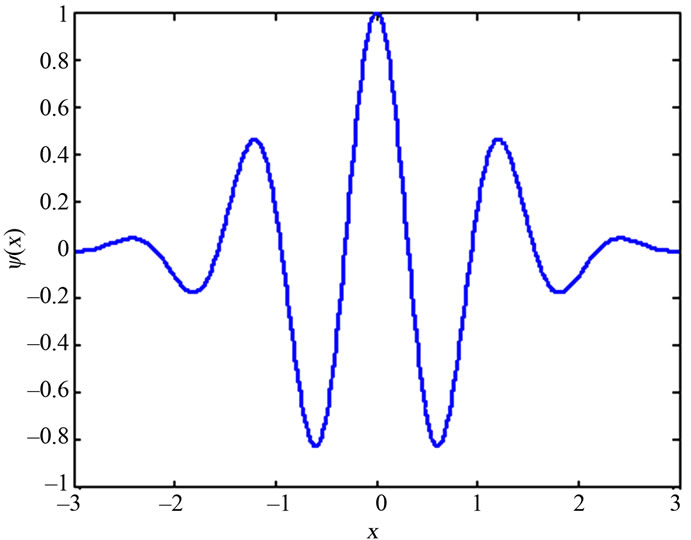
Figure 3. Morlet wavelet.

Figure 4. Morlet wavelet dilated by different values of a (x-axis: a, y-axis: ψa,0(x)).
By using the Morlet wavelet in (7) as the mother wavelet,
 (12)
(12)
Referring to the Property 1 of (5), the total positive momentum of the mother wavelet is equal to the total negative momentum of the mother wavelet. Then, the sum of the positive F is equal to the sum of the negative F when the number of samples is large and  is randomly generated, i.e.
is randomly generated, i.e.
 for
for  (13)
(13)
where N is the number of samples. Hence, the overall positive mutation and the overall negative mutation throughout the evolution are nearly the same in a statistical sense. This property gives better solution stability such that a smaller standard deviation of the solution values upon many trials can be reached. As over 99% of the total energy of the mother wavelet function is contained in the interval [−2.5, 2.5],  can be generated from [−2.5, 2.5] randomly. The value of the dilation parameter a is set to vary with the value of
can be generated from [−2.5, 2.5] randomly. The value of the dilation parameter a is set to vary with the value of  in order to meet the fine-tuning purpose, where T is the total number of iteration and t is the current number of iteration. In order to perform a local search when t is large, the value of a should increase as
in order to meet the fine-tuning purpose, where T is the total number of iteration and t is the current number of iteration. In order to perform a local search when t is large, the value of a should increase as  increases so as to reduce the significance of the mutation. Hence, a monotonic increasing function governing a and
increases so as to reduce the significance of the mutation. Hence, a monotonic increasing function governing a and  is proposed as follows.
is proposed as follows.
 (14)
(14)
where  is the shape parameter of the monotonic increasing function, λ is the upper limit of the parameter a.
is the shape parameter of the monotonic increasing function, λ is the upper limit of the parameter a.
The effects of the various values of the shape parameter  to a with respect to
to a with respect to  are shown in Figure 5. In this figure, l is set as 10,000. Thus, the value of a is between 1 and 10,000. Referring to (12), the maximum value of F is 1 when the random number of
are shown in Figure 5. In this figure, l is set as 10,000. Thus, the value of a is between 1 and 10,000. Referring to (12), the maximum value of F is 1 when the random number of  = 0 and
= 0 and  (at
(at  = 0). Then referring to (9), the vector
= 0). Then referring to (9), the vector  has a large degree of mutation. It ensures that a large search space for the mutated vector is given at the early stage of evolution. When the value
has a large degree of mutation. It ensures that a large search space for the mutated vector is given at the early stage of evolution. When the value  is near to 1, the value of a is so large that the maximum value of F will become very small. For example, at
is near to 1, the value of a is so large that the maximum value of F will become very small. For example, at  = 0.9 and
= 0.9 and , a = 400; if the random value of
, a = 400; if the random value of  is zero, the value of F will be equal to 0.0158. A smaller searching space for the mutated vector is then given for fine-tuning.
is zero, the value of F will be equal to 0.0158. A smaller searching space for the mutated vector is then given for fine-tuning.
2.3.3. Operation of DE Crossover with Wavelet Mutation
The crossover operation of (3) is done with respect to the
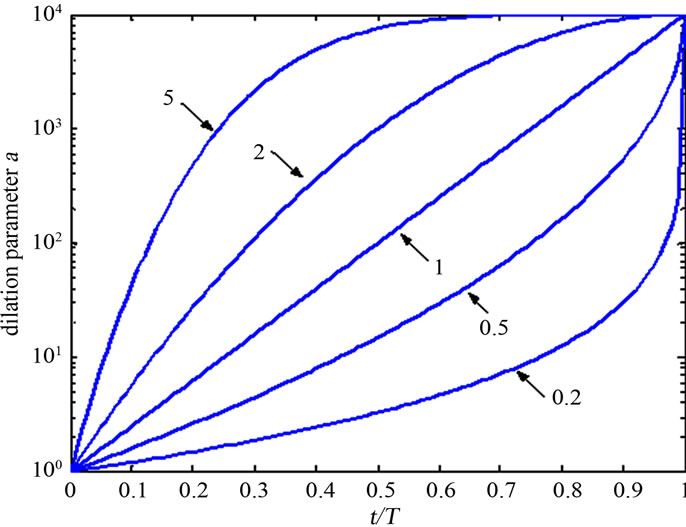
Figure 5. Effect of the shape parameter ξwm to a with respect to t/T.
elements of the trial vector (after mutation) in DE. In DWM-DE, the second-stage wavelet mutation is embedded in the crossover operation. In general, various methods like uniform mutation or non-uniform mutation [17,18] can be employed to realize the mutation operation. In this paper, the second-stage wavelet operation, which exhibits a fine-tuning ability, is realized by adding a second wavelet mutation following the original crossover operation. The crossover after the first mutation takes place according to (3). Let (where g is the current generation number and D is the number of elements in the vector) be the i-th vector after crossover for the second wavelet mutation. The value of the element
(where g is the current generation number and D is the number of elements in the vector) be the i-th vector after crossover for the second wavelet mutation. The value of the element  is inside the vector element’s boundary
is inside the vector element’s boundary
 . The mutated crossover vector is given by
. The mutated crossover vector is given by , and
, and
 (15)
(15)
 (16)
(16)
where the same Morlet wavelet in (7) is used as the mother wavelet and the value of a is governed by (14). Similar to F of (12), a larger value of  at the early stage of evolution gives a larger searching space for the solution; when
at the early stage of evolution gives a larger searching space for the solution; when  is small at the later stage of evolution, the algorithm gives a smaller searching space for fine-tuning.
is small at the later stage of evolution, the algorithm gives a smaller searching space for fine-tuning.
After the operations of the double wavelet mutation, the population is updated by comparing each trial vector  to the corresponding target vector xi,g using the method of standard DE as given by (4). A new population is generated and the same evolution process is repeated. Such an iterative process will be terminated when a defined number of iteration has been met.
to the corresponding target vector xi,g using the method of standard DE as given by (4). A new population is generated and the same evolution process is repeated. Such an iterative process will be terminated when a defined number of iteration has been met.
3. Benchmark Test Functions and Results
3.1. Benchmark Test Functions
A suite of eighteen benchmark test functions [19-22] are used to test the performance of the proposed DWM-DE. Many different kinds of optimization problems are covered by these benchmark test functions. They can be divided into three categories. The first one is the category of unimodal functions, which involves a symmetric model with a single minimum; functions f1-f7 are unimodal functions. The second one is the category of multimodal functions with a few local minima; functions f8-f13 belong to this category. The last one is the category of multimodal functions with many local minima; functions f14-f18 belong to this category. The expressions of these functions are listed in Table 1. (The details about the parameters a, b, and c and the function u(×) for the functions f8, f9 and f12-f14 are given in [22].)
3.2. Experimental Setup
We evaluate the performance of SDE [23], DE with single wavelet mutation (first stage only, SWM-DE), DE/ local-to-best/1 [20], DE/rand/1 with per-vector-dither [24] and the proposed DWM-DE by finding the minimum values of the benchmark test functions. The following simulation conditions are used:
• The shape parameter of the wavelet mutation ( ): It is chosen by trial and error for each function through experiments for good performance.
): It is chosen by trial and error for each function through experiments for good performance.  =1 is used for all functions (A discussion for the value of
=1 is used for all functions (A discussion for the value of  will be given in Section 3.4).
will be given in Section 3.4).
• The parameter  for the monotonic increasing function: 10,000.
for the monotonic increasing function: 10,000.
• Initial population: It is generated uniformly at random.
• Crossover probability constant:  = 0.5.
= 0.5.
• The mutation weight factor (for SDE, DE/local-tobest/1 and DE/rand/1): F = 0.5.
• The population size: 30.
• The numbers of iteration for all algorithms are listed in Table 2.
3.3. Results and Analysis
The simulation results for the 18 benchmark test functions are given to show the merits of the proposed DWM-DE. All results shown are averaged data out of 50 trials.
3.3.1. Unimodal Functions
Function f1 is a sphere model, which is smooth and symmetric. The main purpose of testing this function is to measure the convergence rate of searching. It is probably the most widely used test function. For this function, the results in terms of the mean cost value and the best cost value of the DWM-DE are much better than those of the other methods as shown in Table 3. Also, the standard deviation is small, which means that the searched solutions are stable. In Figure 6(a), the DWM-DE returns a faster convergence rate than other methods thanks to its better searching ability.
Function f2 is the Generalized Rosenbrock’s function, which is also called the Banana function. The global minimum of this function is inside a long, narrow, parabolic shaped flat valley. Owing to the smooth and symmetric characteristic of f2, the main purpose of testing is to measure the convergence rate of the searching algorithms. The result is shown in Figure 6(b). The convergence rate of the proposed DWM-DE is the highest. When using the proposed DWM-DE, the solution quality is increased when the number of iteration increases. As there is only one minimum within the solution space,

Table 1. Benchmark test functions.
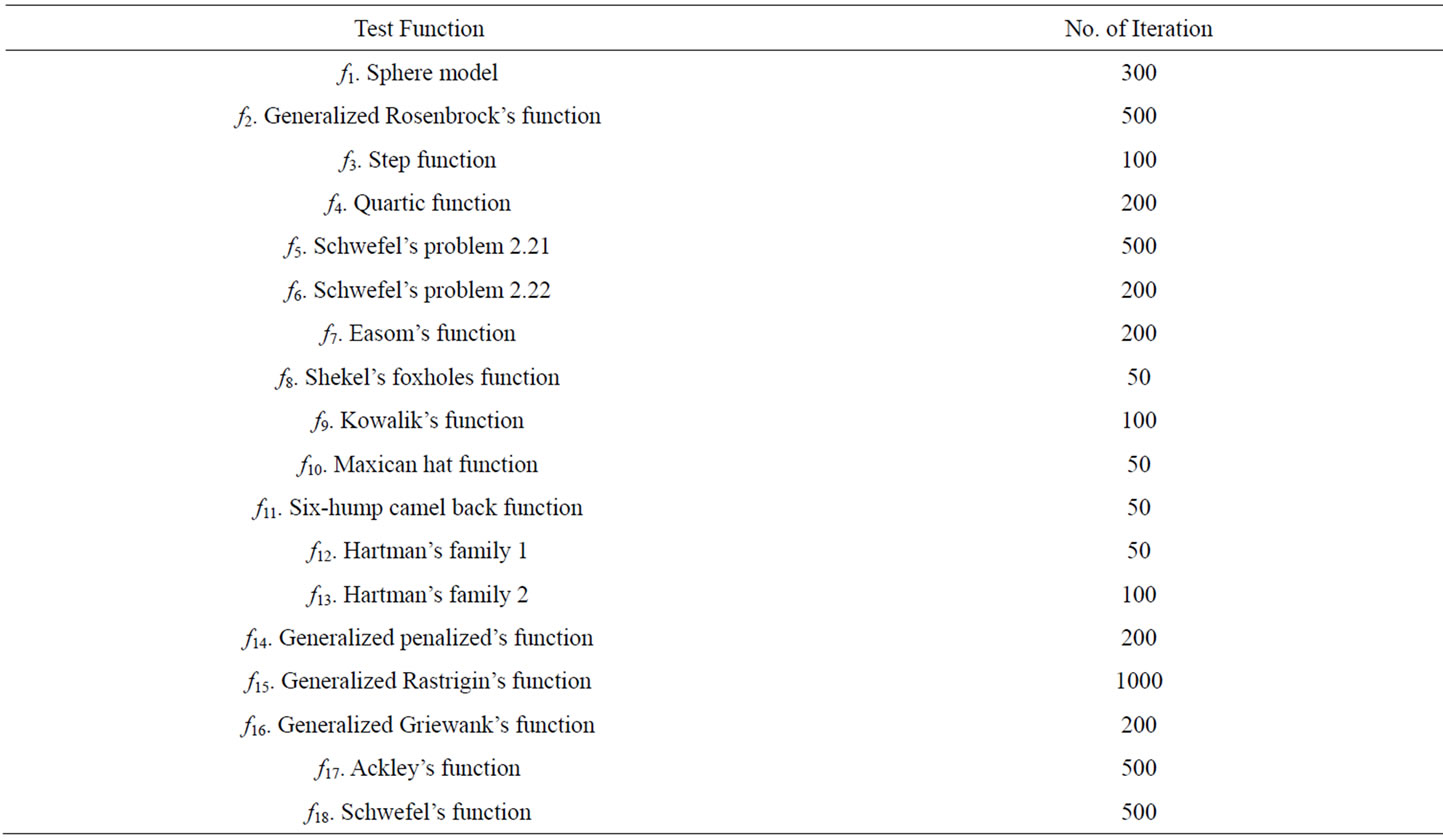
Table 2. Number of iteration in the experiments.
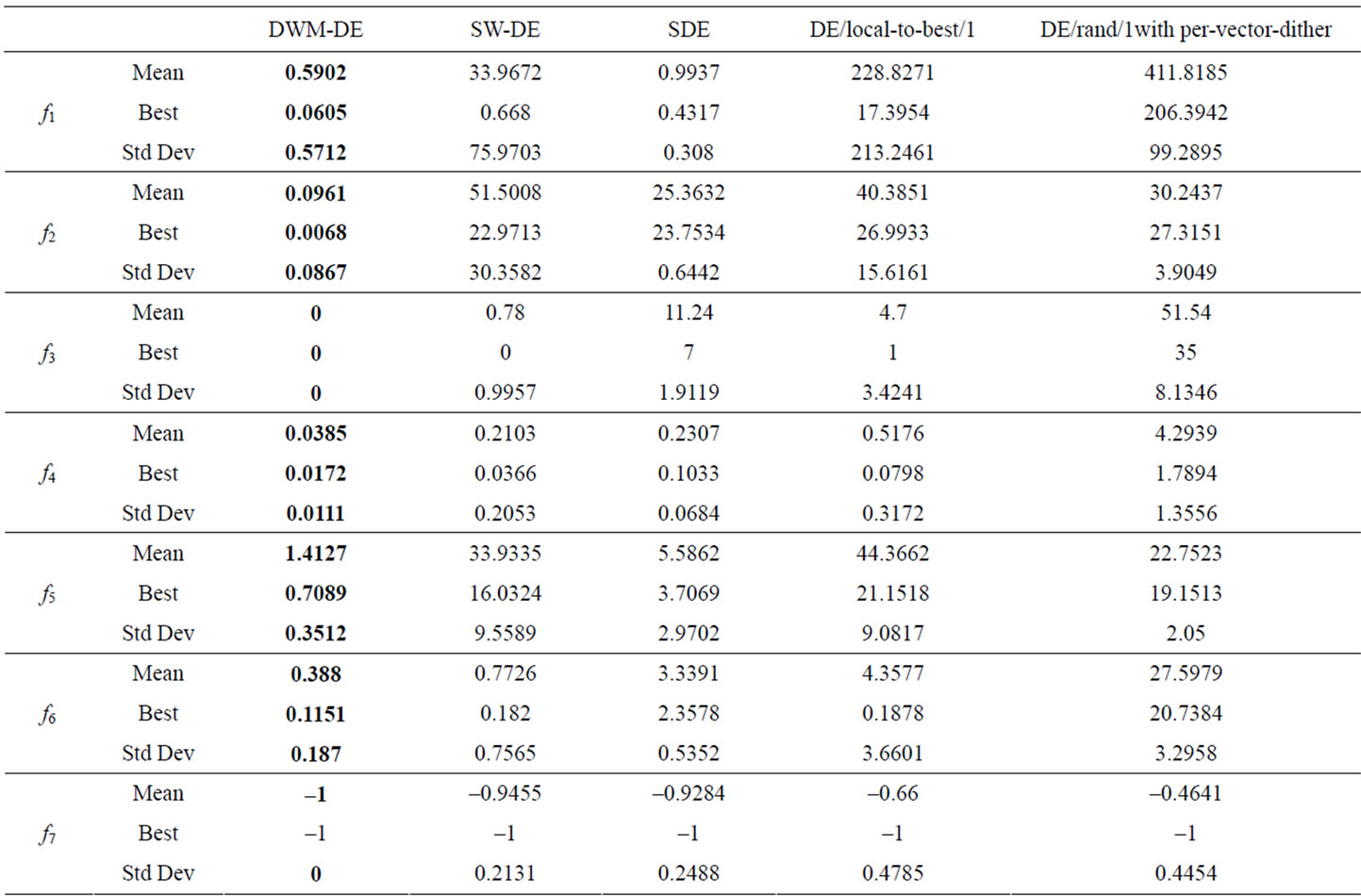
Table 3. Comparison between different de methods for benchmark test functions (category 1). All results are averaged ones over 50 runs.
 (a)
(a)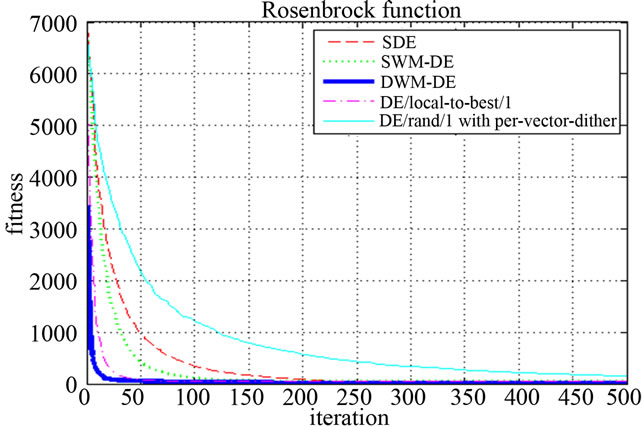 (b)
(b) (c)
(c)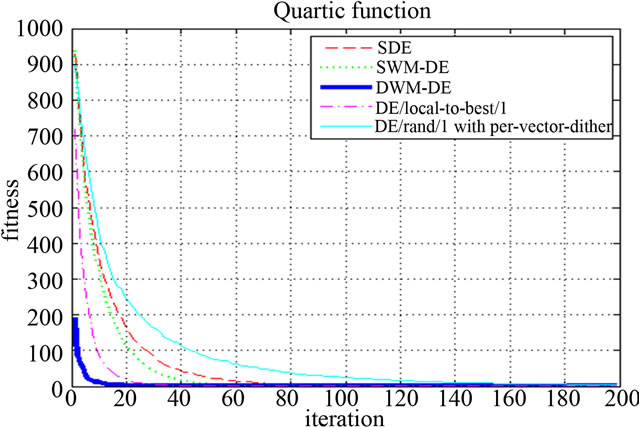 (d)
(d) (e)
(e)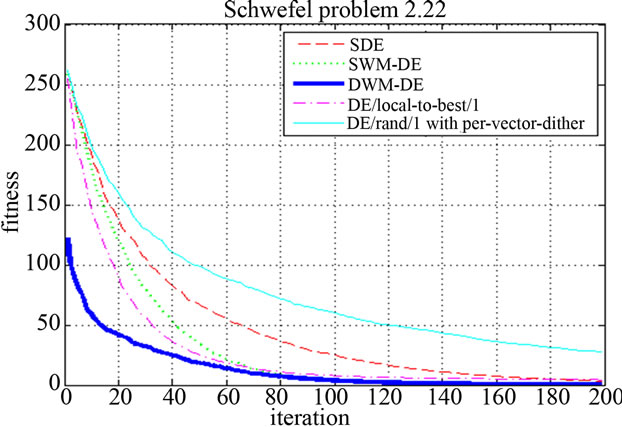 (f)
(f) (g)
(g)
Figure 6. Unimodal functions.
nearly all the population will move towards that minimum. Yet, The DWM-DE performs better than the other methods in terms of the mean value and the standard deviation as shown in Table 3.
Function f3 is the Step function with many flat surfaces. Flat surfaces are obstacles for optimization algorithms because they do not give any information about the search direction. Unless the algorithm has a variable step size, it can get stuck in one of the flat surfaces. All hybrid DEs that involve the mutation operation are good for this function as shown in Figure 6(c) because it can generate a long jump by using mutation operations during the evolution.
Function f4 is the Quartic function. Since it is a polynomial of even degree, it approaches the same limit when the argument goes to positive or negative infinity. Thus the function has a global minimum. The results are shown in Figure 6(d) and Table 3. We can see that the convergence rate of the proposed DWM-DE is much greater than that of SDE. After around 10 times of iteration, the proposed method is able to reach the minimum.
Functions f5 and f6 are the Schwefel’s problem 2.21 and Schwefel’s problem 2.22. The best value, mean cost value and the standard derivation of the DWM-DE are the best as shown in Table 3. Thus, the proposed algorithm gives better solution quality and stability.
Function f7 is the Easom function where the global minimum is near a small area relative to the search space. The function was inverted for minimization. The result is shown in Figure 6(g). For this function, the convergence rate of the proposed DWM-DE is high. While the convergence rate of DWM-DE is nearly the same as DE with single wavelet mutation only, the solution quality on using DWM-DE is better than the other algorithms during the early evolution. The proposed algorithm gives better performance in terms of convergence rate, solution quality and stability as shown in Table 3.
For unimodal functions, the proposed DWM-DE can offer a higher rate of convergence. By adopting the Morlet wavelet on controlling the scaling factor F, the degree of freedom of the trial vectors can be increased. More directions of exploration would be generated during the mutation operation. Moreover, based on the fine-tuning ability of the wavelet operations, the population can easily reach the small region around the global minimum. In short, the DWM-DE is the best to tackle unimodal functions when compared with the other methods.
3.3.2. Multimodal Functions with a Few Local Minima
Six multimodal functions with a few local minima are used to evaluate the five algorithms. Those functions are Shekel’s foxholes function, Kowalik’s function, Maxican hat function, Six-hump camel back function, Hartman’s family 1 and Hartman’s family 2. All of them contain some local minima within the searching space. The experimental results for these functions are listed in Table 4 and shown in Figure 7. For all the functions, it is found that all the searching methods perform similarly in reaching the optimal point. While the functions contain a few local minima, all the searching methods do not get trapped in the local minima easily. The advantage brought by the double wavelet mutation operations to the searching is not obvious for these functions. Yet, the solution quality and stability offered by DWM-DE are good.

Table 4. Comparison between different de methods for benchmark test functions (category 2). All results are averaged ones over 50 runs.
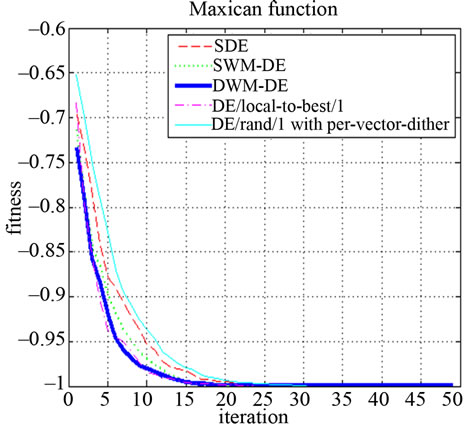 (a)
(a) (b)
(b)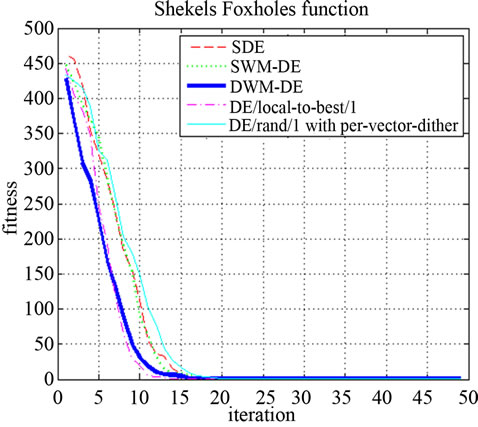 (c)
(c)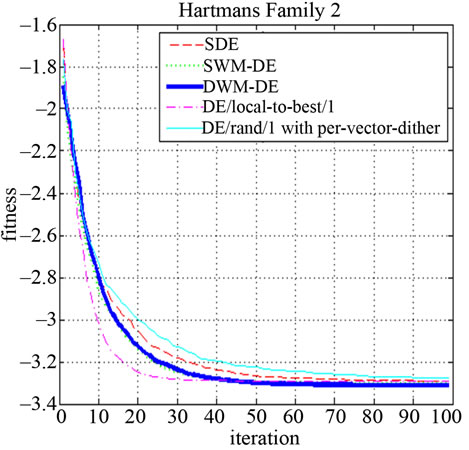 (d)
(d)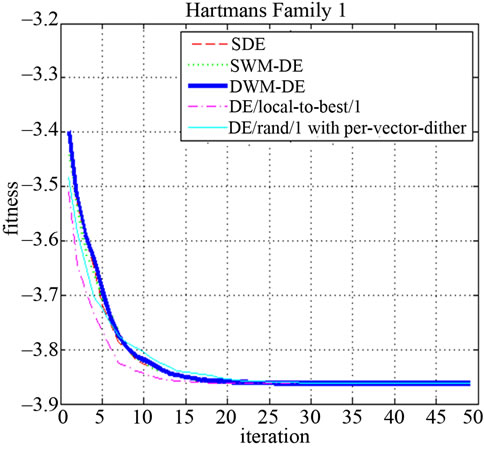 (e)
(e)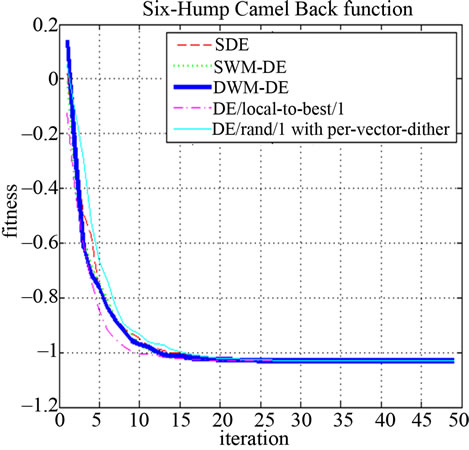 (f)
(f)
Figure 7. Multimodal functions with a few local minma.
3.3.3. Multimodal Functions with Many Local Minima
Functions f14-f18 are multimodal functions with many local minima. The experimental results for these functions are listed in Table 5 and shown in Figure 8. Function f14, f15 and f16 are the Generalized penalized’s function, Generalized Rastrigin’s function and Generalized Griewank’s function respectively. They are widely used as test functions for global optimization. Those functions have an exponentially increasing number of local minima as their dimension increases, and the locations of the minima are regularly distributed. In the experiment, the dimension is 30. As a result, the function contains plenty of local minima. From Figure 8, we can see that if the wavelet mutation is used, the rate of convergence is much improved. By adding the double wavelet mutation operations to the DE, we can reduce the chance that the searching process is trapped in some local minima. Moreover, by introducing the second wavelet mutation to DE, the searching process of DWM-DE is capable of moving closely to the global minimum in the early iteration stage. Thanks to the property of the second wavelet mutation, the effort on searching and evaluating those local minima that are far away from the global minimum is reduced.
Function f17 is the Generalized Ackley’s function, which is a continuous multimodal function obtained by modulating an exponential function with a cosine wave of moderate amplitude. Its topology is characterized by an almost flat outer region and a central hole or peak where the modulation of the cosine wave becomes more and more influential. The result is shown in Figure 8(d). It shows that if the double wavelet mutation operations are used with DE, the fitness of the function dropped rapidly. After 250 times of iteration, the fitness becomes near the global minimum. However, even DE with single wavelet mutation cannot satisfactorily reach the global minimum. It shows the advantage the double wavelet mutation operations on reducing the effort for searching and evaluating those local minima that are far away from the global minimum.
Function f18 is the Schwefel’s function, which is deceptive in that the global minimum is geometrically distant from the next best local minima. Therefore, the search algorithms are potentially prone to converge to the wrong direction. The result is shown in Figure 8(e). Similar to functions f16 and f17, if the double wavelet mutation operations are used, the convergence rate is much improved. The DWM-DE can move closely to the global minimum at the early iteration stage.

Table 5. Comparison between different de methods for benchmark test functions (category 3). All results are averaged ones over 50 runs.
 (a)
(a) (b)
(b)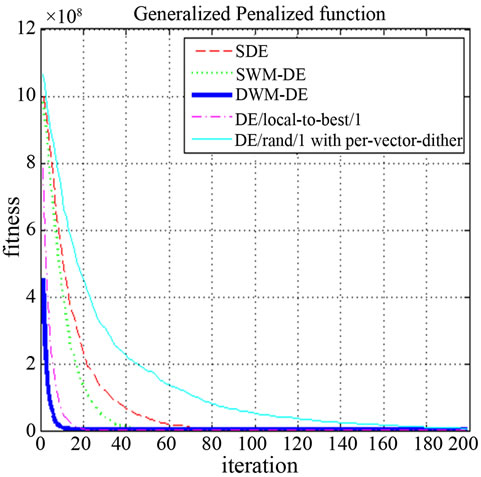 (c)
(c) (d)
(d)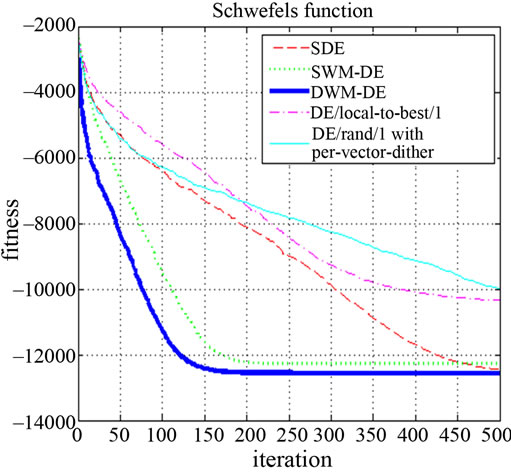 (e)
(e)
Figure 8. Multimodal functions with many local minima.
For multimodal functions with many local minima, the proposed DWM-DE can significantly improve the convergence rate and the chance of reaching the global optimum as compared to the other algorithms.
3.4. The t-Test
The t-test is a statistical method to evaluate the significant difference between two methods. The t-value will be positive if the first method is better than the second, and it is negative if it is poorer. The t-value is defined as follows:
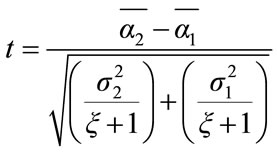 (17)
(17)
where  and
and  are the mean values of the first and second methods, respectively; σ1 and σ2 are the standard deviations of the first and second methods, respectively; and ξ is the value of the degree of freedom. When the t-value is higher than 1.645 (with ξ = 49 for 50 runs), there is a significant difference between the two algorithms with a 95% confidence level. The t-values between the DWM-DE and other optimization algorithms are shown in Table 6. The N/A in the table means the result of t-test is undefined. We see that most of the t-values in this table are higher than 1.645. Therefore, the performance of the DWM-DE is significantly better than that of other optimization algorithms with a 95% confidence level.
are the mean values of the first and second methods, respectively; σ1 and σ2 are the standard deviations of the first and second methods, respectively; and ξ is the value of the degree of freedom. When the t-value is higher than 1.645 (with ξ = 49 for 50 runs), there is a significant difference between the two algorithms with a 95% confidence level. The t-values between the DWM-DE and other optimization algorithms are shown in Table 6. The N/A in the table means the result of t-test is undefined. We see that most of the t-values in this table are higher than 1.645. Therefore, the performance of the DWM-DE is significantly better than that of other optimization algorithms with a 95% confidence level.
3.5. Sensitivity of the Shape Parameter for the WM
The mean cost values offered by the DWM-DE under different values of the shape parameter  for all test functions in Section 3.1 are listed in Table 7. The functions are tested by using
for all test functions in Section 3.1 are listed in Table 7. The functions are tested by using  = 0.2, 0.5, 1, 2, and 5. In this experiment, the parameter λ is fixed at 10,000. If the optimization problem needs a more significant mutation to reach the optimal point, a smaller
= 0.2, 0.5, 1, 2, and 5. In this experiment, the parameter λ is fixed at 10,000. If the optimization problem needs a more significant mutation to reach the optimal point, a smaller  should be used. Conversely, if the DWM-DE needs to perform the fine-tuning faster, a larger
should be used. Conversely, if the DWM-DE needs to perform the fine-tuning faster, a larger  should be used. In general, if the function is smooth and symmetric, the searching algorithms should be fast to jump to the area near the global optimum and then perform the fine-tuning. Therefore, a smaller
should be used. In general, if the function is smooth and symmetric, the searching algorithms should be fast to jump to the area near the global optimum and then perform the fine-tuning. Therefore, a smaller  can be set (
can be set ( = 0.2) so that the DWM-DE will perform more significant mutation in order to increase its speed of convergence. In some cases, the value of
= 0.2) so that the DWM-DE will perform more significant mutation in order to increase its speed of convergence. In some cases, the value of  is not very critical, e.g. in f7, f8 and f9. For f7, the mean cost values under different values of
is not very critical, e.g. in f7, f8 and f9. For f7, the mean cost values under different values of  are nearly the same. However, in some cases, the value of the parameter
are nearly the same. However, in some cases, the value of the parameter  is sensitive to the performance of the searching, e.g. in f2 and f5. In conclusion, no formal method is available to choose the value of the parameter
is sensitive to the performance of the searching, e.g. in f2 and f5. In conclusion, no formal method is available to choose the value of the parameter ; it depends on the characteristics of the optimization problems.
; it depends on the characteristics of the optimization problems.
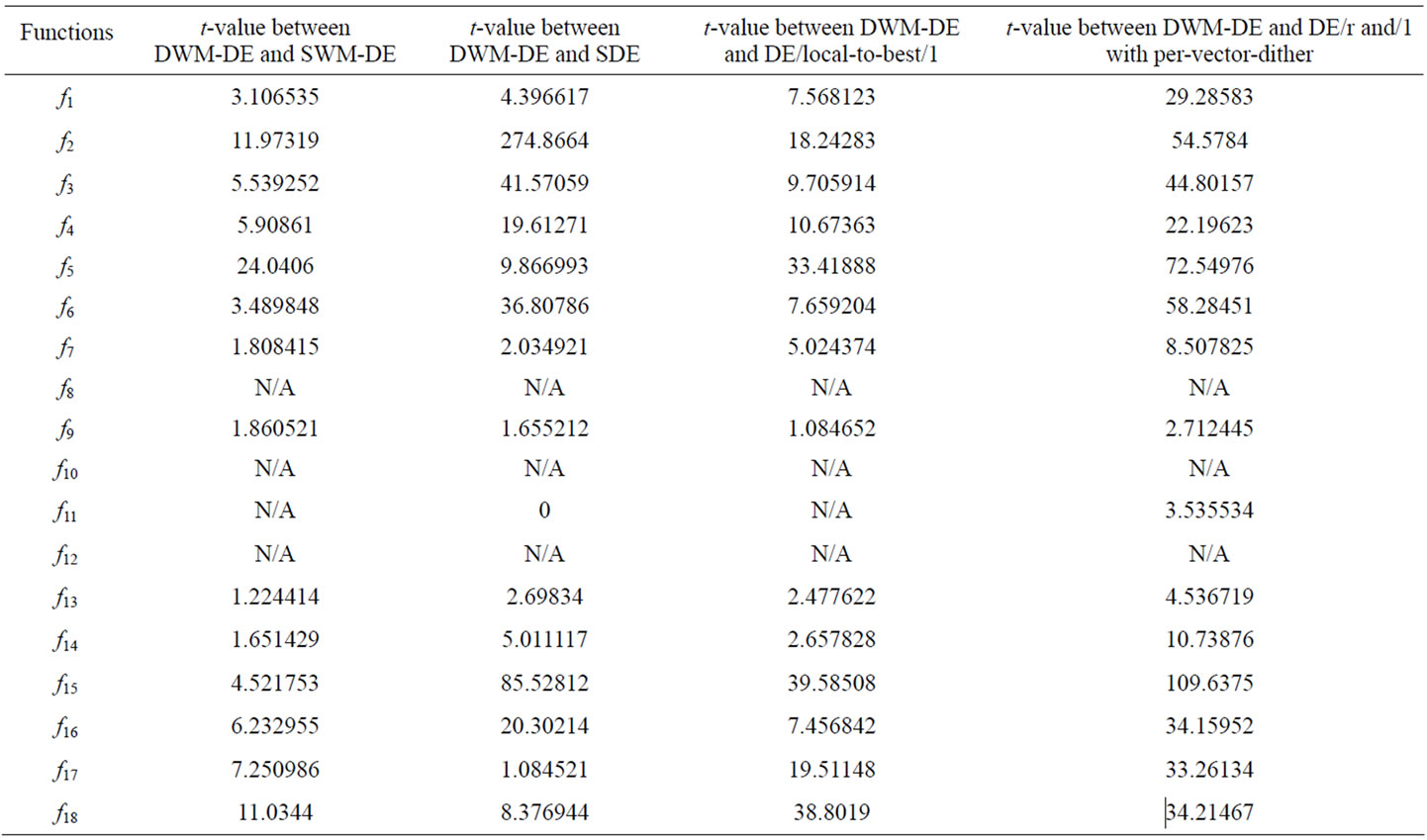
Table 6. t-value between dwm-de and other de methods.

Table 7. Sensitivity of the shape parameter zwm for wavelet mutation.
3.6. Sensitivity of the Parameter λ for the WM
The mean cost values offered by the DWM-DE with different values of the WM’s parameter λ for all test functions are tabulated in Table 8. The functions are tested by using λ = 100, 1000, 10,000, and 100,000. In this experiment, the parameter ζwm is fixed at 1. If we want a smaller value of the upper limit (the searching limit) of the particle’s mutated element, a larger value of λ should be used. In some cases, the parameter λ is not very sensitive, such as f3-f4, f7-f13, f16 and f18. The mean cost values under different values of λ have no significant difference. However, in some cases, such as f1, the value of the parameter λ is sensitive to the performance of the DWMDE. In f1, the mean cost value is 0.3202 when λ = 100, and the mean cost value is 1.4945 when λ = 100,000. Their difference is around 5 times. In conclusion, similar to the parameter ζwm, no formal method is available to choose the value of the parameter λ. It depends on the characteristics of the optimization problem. Comparing with the sensitivity of the shape parameter ζwm, the parameter λ is less sensitive to the performance of the searching.

Table 8. Sensitivity of the parameter λ for wavelet mutation.
4. The Economic Load Dispatch with Valve-Point Loading Problem
The Economic Load Dispatch with Valve-Point Loading (ELD-VLP) is a method to control or schedule a group of power generator outputs with respect to the load demands, and operate a power system economically so as to minimize the operation cost of the power system. Because of the valve-point loadings and rate limits, the input-output characteristics of modern generators are nonlinear by nature. As a result, the characteristics of ELDVPL problems are multimodal, discontinuous, and highly nonlinear. In this paper, the DWM-DE is employed to solve the ELD-VPL problem, which aims at minimizing the following objective function:
 (18)
(18)
where Ci(PLi) is the operation fuel cost of generator i, and n denotes the number of generators. The problem is subject to balance constraints and generating capacity constraints as follows.
 (19)
(19)
 (20)
(20)
where DL is the load demand, PLi is the output power of the i-th generator, PLoss is the transmission loss, and  and
and  are the maximum and minimum output power of the i-th generator, respectively. The operation fuel cost function is given by
are the maximum and minimum output power of the i-th generator, respectively. The operation fuel cost function is given by
 (21)
(21)
where ai, bi, and ci are the coefficients of the cost curve of the i-th generator.
To obtain the practical ELD solution, the operation of the ELD problem should be considered with the valvepoint effects. Typically, to model the effects of valve points, a rectified sinusoidal term is added to the cost function:
 (22)
(22)
where ei and fi are the coefficients of the valve point loadings. The generating units with multivalve steam turbines exhibit a greater variation in the fuel cost functions. In practice, the valve-point effects introduce ripples in the heat-rate curves.
To solve the ELD-VPL problem by using DWM-DE, the solution representation of elements in the population is defined as follows:
 (23)
(23)
From (16), we have
 (24)
(24)
In this paper, the power loss is not considered; therefore , and
, and
 (25)
(25)
Based on the problem defined above, the objective of this optimization problem is to minimize the total fuel cost based on (22) by using DWM-DE.
5. The Experiment and Result of the ELD-VPL Problem
In this paper, ELD-VPL problem with 13 and 40 generators system with a non-smooth fuel cost function with sinusoidal terms are used to test the performance of the proposed DWM-DE method. The results obtained are compared with those reported in the literature. Both the 13- and 40-generator systems have non-convex solution spaces with many local minima. As a result, the global minimum is difficult to determine. For the 13-generator system, the total load demand of 1800 MW is tested. For the 40-generator system, the total load demand of 10,500 MW is tested. The parameters for the 13- and 40-generator systems are shown in Tables 9 and 10 respectively. By using the WDM-DE, the following simulation conditions are used:
• Shape parameter of the wavelet mutation ( ): 1.
): 1.
• Parameter  for the monotonic increasing function: 10,000.
for the monotonic increasing function: 10,000.
• Initial population: It is generated uniformly at random.
• Crossover probability constant: Cr = 0.5.
• Mutation weight factor (For SDE): F = 0.5.
• Numbers of iteration: 500.
• Number of population: 50.
All results shown are averaged ones out of 100 trials. The statistical results in terms of the mean cost value, the best cost value, and the standard deviation are shown in Table 11. From the result obtained in this experiment, we find that the DWM-DE performs much better than the other DE methods. The DWM-DE can offer the best (minimum) cost. The average cost for the 13-generator system is $17,996.43, and the best (minimum) cost is
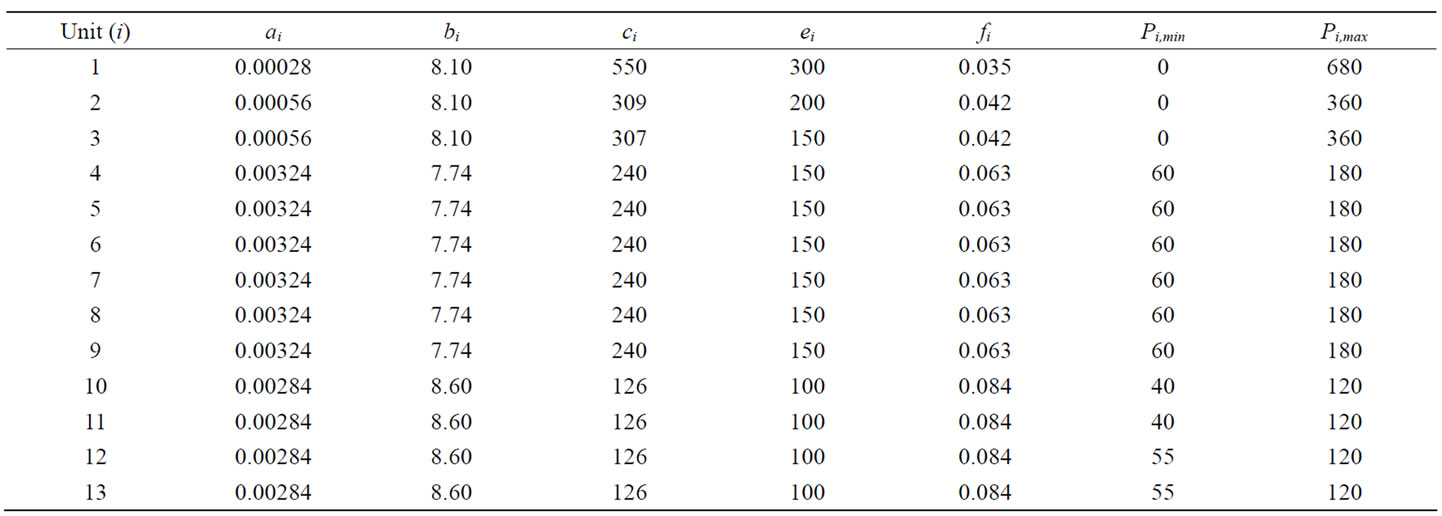
Table 9. Parameters for the 13 generators system.
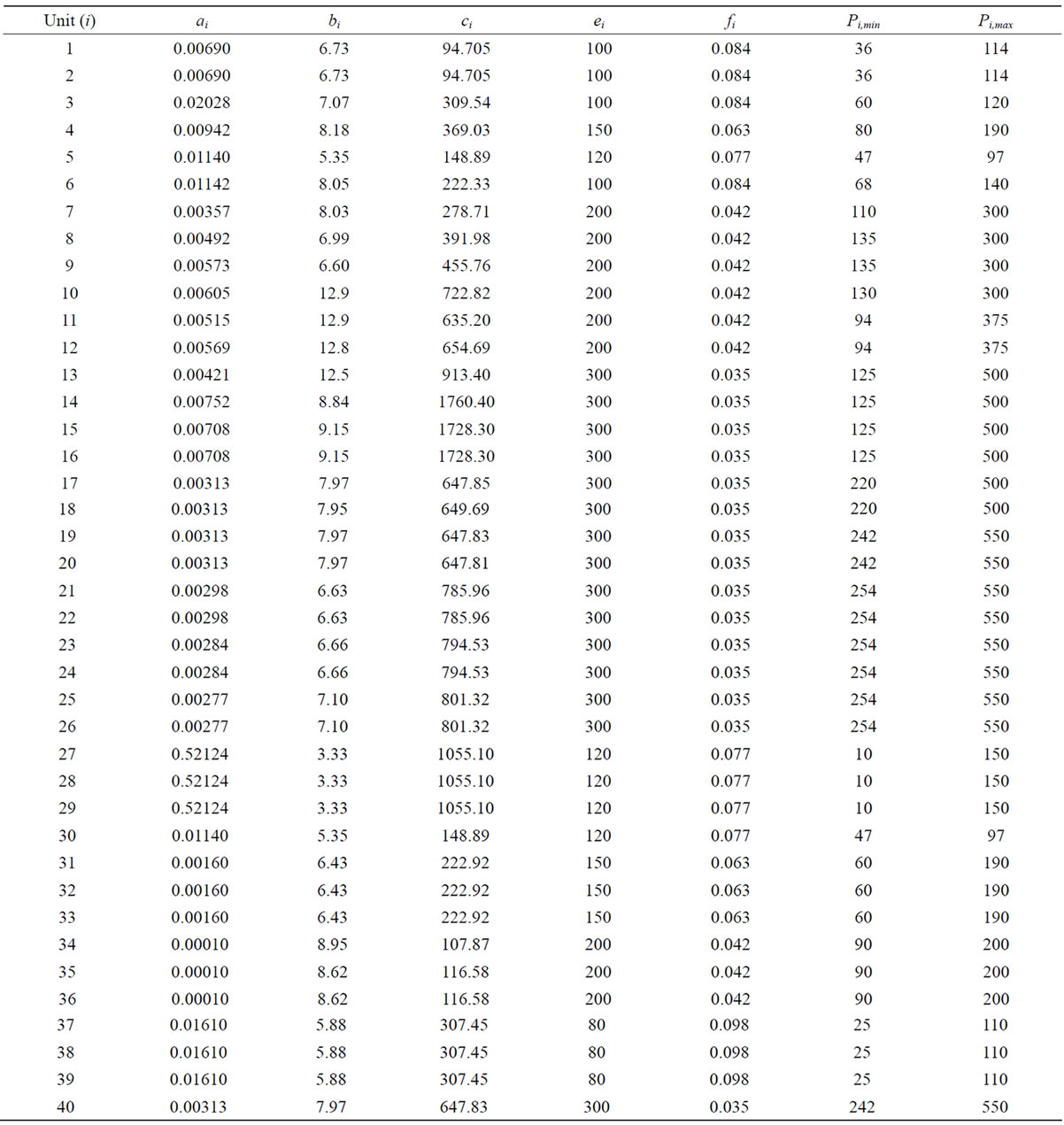
Table 10. Parameters for the 40 generators system.

Table 11. Result of the ELD-VPL problem.
$17,972.78. For the 40-generator system, the average cost is $121,521.79, and the best (minimum) cost is $121,431.63. Moreover, the smallest standard deviation is also obtained by using DWM-DE. Thanks to the wavelet properties, the stability of the optimization solution is improved. In the ELD-VPL problem, the solution stability is very important. Since the load demand is changing with time. A stable optimization method can offer a better quality of the power generation service. To conclude, the convergence speed, solution quality and solution stability of the DWM-DE are good. DWM-DE is suitable to be applied to the ELD-VPL problem.
Table 12 summarized the best results obtained by DWM-DE, DEC-SQP [4] and IGA [25,26] for comparison. The result shows that the DEC-SQP performs the best for the 13-generator system. The best cost is $17,938.95, while the best cost of DWM-DE is $17,972.78. Although, the DWM-DE method cannot offer the best result, the result is already very near to the DEC-SQP method. As the dimension of the 13-generator system is relatively small, the wavelet based mutations of DWM-DE might not be able to enhance the searching process very effectively. For the 40-generator system, the best result of DWM-DE, MPSO [2], DEC-SQP [4] and NPSO-LRS [27] are summarized in Table 13. Among the 4 methods, DWM-DE offers the best result. The best cost for the 40-generator system is $121,431.63. Since the dimension of the 40-generator system is large, the wavelet based mutations of DWM-DE can enhance the searching process effectively and it does not trap into some local minimum easily. For the ELD-VPL problem, to obtain the best result, we suggest applying DWM-DE for the high dimensional cases; for example, a dimension higher than 30.
6. Conclusion
In this paper, we have proposed an improved Differential Evolution (DE) that incorporates double wavelet-based mutations to handle the ELD-VPL problem. In the first mutation operation, a scheme on tuning the scaling factor F of the DE algorithm that applies a wavelet function is proposed. In the crossover operation of DE, a second mutation operation for modifying the trial population vectors that applies a wavelet function is proposed. The resulting DWM-DE takes advantage of the properties of the wavelet function to improve the solution quality and stability. The proposed method can explore the solution space more effectively in reaching the global solution. Simulation results have shown that the proposed double-wavelet-mutation based DE is a useful algorithm to solve a suite of 18 benchmark test functions, and offers better results in terms of convergence rate, solution quality and stability. Moreover, the ELD-VPL problem is solved by the DWM-DE. It is shown empirically that the proposed method out-performs significantly the conven

Table 12. Comparison with other published results for the 13 generators system (load = 1800 mw).

Table 13. Comparison with other published results for the 40 generators system (load = 10,500 mw).
tional methods in terms of convergence speed, solution quality and solution stability, especially when the dimension of the problem is high.
7. Acknowledgements
The work described in this paper was substantially supported by a grant from The Hong Kong Polytechnic University (Project No. RP9L).
REFERENCES
- R. J. M. Vaessens, E. H. L. Aarts and J. K. Lenstra, “A Local Search Template,” Proceedings of Parallel Problem Solving Nature, Brussels, 28-30 September 1992, pp. 65-74.
- J. B. Park, K. S. Lee and K. Y. Lee, “A Particle Swarm Optimization for Economic Dispatch with Non-Smooth Cost Functions,” IEEE Transactions on Power Systems, Vol. 20, No. 1, 2005, pp. 34-49. doi:10.1109/TPWRS.2004.831275
- T. A. A. Victoire and A. E. Jeyakumar, “Hybrid PSOSQP for Economic Dispatch with Valve-Point Effect,” Electrical Power Systems Research, Vol. 71, No. 1, 2004, pp. 51-59. doi:10.1016/j.epsr.2003.12.017
- L. S. Coelho and V. C. Mariani, “Combining of Chaotic Differential Evolution and Quadratic Programming for Economic Dispatch Optimization with Valve-Point Effect,” IEEE Transactions on Power Systems, Vol. 21, No. 2, 2006, pp. 989-995.
- R. Storn and K. Price, “Differential Evolution—A Simple and Efficient Heuristic for Global Optimization over Continuous Spaces,” Journal of Global Optimization, Vol. 11, No. 4, 1997, pp. 341-359. doi:10.1023/A:1008202821328
- L. Fogel, “Evolutionary Programming in Perspective: The Top-Down View,” In: J. M. Zurada, R. J. Marks and C. J. Robinson, eds., Computational Intelligence: Imitating Life, IEEE Press, Piscataway, 1994, pp. 135-146.
- D. Goldberg, “Genetic Algorithms in Search Optimization and Machine Learning,” Addison-Wesley, Boston, 1989.
- X. Yao and Y. Liu, “Evolutionary Programming Made Faster,” IEEE Transactions Evolutionary Computation, Vol. 3, No. 2, 1999, pp. 82-102. doi:10.1109/4235.771163
- Y. Ao and H. Chi, “Differential Evolution Using Opposite Point for Global Numerical Optimization,” Journal of Intelligent Learning Systems and Applications, Vol. 4, No. 1, 2012, pp. 1-19. doi:10.4236/jilsa.2012.41001
- S. Paterlini and T. Krink, “High Performance Clustering with Differential Evolution,” 2004. http://dsp.szu.edu.cn/dsp2006/research/areas/t08/papers/Clustering/03.High%20performance%20clustering%20with %20differential%20evolution.pdf
- J. H. van Sickel, K. Y. Lee and J. S. Heo, “Differential Evolution and Its Applications to Power Plant Control,” Proceedings of Intelligent Systems Applications to Power System, Kaohsiung, 5-8 November 2007, pp. 1-6.
- B. Babu and R. Angira, “Optimization of Non-Linear Functions Using Evolutionary Computation,” Proceedings of 12th ISME International Conference on Mechanical Engineering, India, 2001, pp. 153-157.
- A. Qing, “Dynamic Differential Evolution Strategy and Applications in Electromagnetic Inverse Scattering Problems,” IEEE Transactions on Geoscience and Remote Sensing, Vol. 44, No. 1, 2006, pp. 116-125. doi:10.1109/TGRS.2005.859347
- R. Eberhart and J. Kennedy, “A New Optimizer Using Particle Swarm Theory,” Proceedings of 6th International Symposium on Micro Machine and Human Science, Nagoya, 4-6 October 1995, pp. 39-43. doi:10.1109/MHS.1995.494215
- J. Vesterstroem and R. Thomsen, “A Comparative Study of Differential Evolution, Particle Swarm Optimization, and Evolutionary Algorithms on Numerical Benchmark Problems,” Congress on Evolutionary Computation, Portland, 19-23 June 2004, pp. 1980-1987.
- I. Daubechies, “Ten Lectures on Wavelets,” Society for Industrial and Applied Mathematics, Philadelphia, 1992. doi:10.1137/1.9781611970104
- Z. Michalewicz, “Genetic Algorithm + Data Structures = Evolution Programs,” 2nd Edition, Springer-Verlag, New York, 1994.
- A. Neubauer, “A Theoretical Analysis of the Non-Uniform Mutation Operator for the Modified Genetic Algorithm,” IEEE International Conference on Evolutionary Computation, Indianapolis, 13-16 April 1997, pp. 93-96.
- J. Brest, S. Greiner, B. Bošković, M. Mernik and V. Žumer, “Self Adapting Control Parameters in Differential Evolution: A Comparative Study on Numerical Benchmark Problems,” IEEE Transactions on Evolutionary Computation, Vol. 10, No. 6, 2006, pp. 646-657. doi:10.1109/TEVC.2006.872133
- Y. Ao and H. Chi, “Experimental Study on Differential Evolution Strategies,” Proceedings of Global Congress on Intelligent Systems, Anqing, 19-24 May 2009, pp. 19- 24. doi:10.1109/GCIS.2009.31
- H. Y. Fan and J. Lampinen, “A Trigonometric Mutation Operation to Differential Evolution,” Journal of Global Optimization, Vol. 27, No. 1, 2003, pp. 105-129. doi:10.1023/A:1024653025686
- M. M. Ali, C. Khompatraporn and Z. B. Zabinsky, “A Numerical Evaluation of Several Stochastic Algorithms on Selected Continuous Global Optimization Test Problems,” Journal of Global Optimization, Vol. 31, No. 4, 2005, pp. 635-672. doi:10.1007/s10898-004-9972-2
- U. K. Chakraborty, “Advances in Differential Evolution,” Springer, Heidelberg, 2008.
- S. Rahnamayan, H. R. Tizhoosh and M. M. A. Salama, “Opposition-Based Differential Evolution,” IEEE Transactions on Evolutionary Computation, Vol. 12, No. 1, 2008, pp. 64-79. doi:10.1109/TEVC.2007.894200
- P. H. Chen and H. C. Chang, “Large-Scale Economic Dispatch by Genetic Algorithms,” IEEE Transactions on Power Systems, Vol. 10, No. 1, 1995, pp. 117-124.
- S. H. Ling, H. C. C. Iu, K. Y. Chan, H. K. Lam, C. W. Yeung and F. H. F. Leung, “Hybrid Particle Swarm Optimization with Wavelet Mutation and Its Industrial Applications,” IEEE Transactions on Systems, Man, and Cybernetics, Part B, Vol. 38, No. 3, 2008, pp. 743-763.
- A. I. Selvakumar and K. Thanushkodi, “A New Particle Swarm Optimization Solution to Non Convex Economic Dispatch Problems,” IEEE Transactions on Power Systems, Vol. 22, No. 1, 2007, pp. 42-50. doi:10.1109/TPWRS.2006.889132

